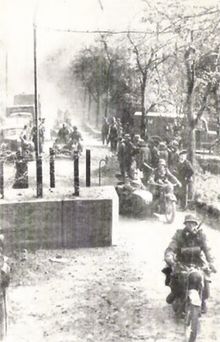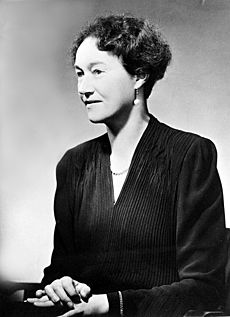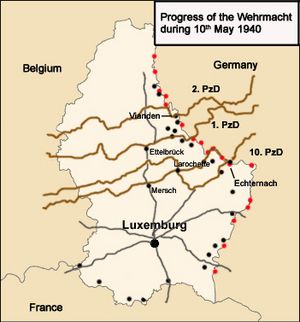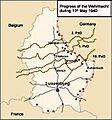German invasion of Luxembourg facts for kids
Quick facts for kids German invasion of Luxembourg |
|||||||||
|---|---|---|---|---|---|---|---|---|---|
| Part of the German invasion of France and the Low Countries in World War II | |||||||||
 German troops crossing into Luxembourg through the Schuster Line |
|||||||||
|
|||||||||
| Belligerents | |||||||||
Supported by: |
|||||||||
| Commanders and leaders | |||||||||
| Strength | |||||||||
| Luxembourg: 425 soldiers 246 gendarmes France: 18,000 soldiers United Kingdom: No. 226 Sqdn. RAF |
50,000 soldiers 600 tanks |
||||||||
| Casualties and losses | |||||||||
| Luxembourg: 7 wounded 76 captured France: 5 killed United Kingdom: 1 killed 2 captured 1 aircraft destroyed |
36 killed 52 wounded |
||||||||
The German invasion of Luxembourg was a quick attack by Nazi Germany on Luxembourg during World War II. It was part of Germany's bigger plan, called "Case Yellow," to invade the Low Countries (which included Belgium, Luxembourg, and the Netherlands) and France. The invasion started on May 10, 1940, and was over in just one day.
German troops faced very little resistance. They quickly took control of Luxembourg. The government of Luxembourg, along with its leader, Grand Duchess Charlotte, managed to escape the country. They then set up a government that ruled from London, called a government-in-exile.
Contents
How the War Started
On September 1, 1939, Germany invaded Poland. This event started World War II. Luxembourg found itself in a difficult spot. Its people supported countries like the United Kingdom and France. However, Luxembourg had a policy of being neutral since 1867. This meant it could not take sides in wars.
Because of this neutrality, Luxembourg had only a small military force. It was called the Corps des Gendarmes et Volontaires. This group included a small army unit called the Volunteer Corps and a police force called the Grand Ducal Gendarmerie.
Radio and Border Defenses
To show it was truly neutral, Radio Luxembourg stopped most of its broadcasts on September 1, 1939. It only aired short government messages each day. This was to prevent anyone from thinking Luxembourg was taking sides.
As the war continued, people in Luxembourg became worried. In the spring of 1940, Luxembourg built defenses along its borders with Germany and France. This defense line was called the Schuster Line. It had concrete blocks and iron gates to stop tanks and vehicles. Since Luxembourg's small army didn't have engineers for building, civilians helped. France also gave advice on how to build these defenses.
Nine radio outposts were set up along the German border. Police officers (gendarmes) staffed these posts. They could send messages to a main radio receiver in the capital.
Planning for an Invasion
On January 4, 1940, Grand Duchess Charlotte and her government met. They made plans for what to do if Germany invaded. Grand Duchess Charlotte decided that she and the government should leave the country if an attack happened. This was important because during World War I, her older sister, who was then Grand Duchess, stayed in Luxembourg during the German occupation. This had caused problems for the royal family. Charlotte wanted to avoid that.
The government also moved some of Luxembourg's gold money to Belgium. They also saved money in banks in Brussels and Paris. This was in case they needed funds if they had to flee. They even sent a secret message to the French government in Paris. It asked for military help if communications were cut during an invasion.
As spring 1940 arrived, it seemed more and more likely that Germany and France would fight. German spies, pretending to be tourists, entered Luxembourg. A French intelligence officer in Luxembourg City noticed them. He reported that these spies might try to capture important bridges. Luxembourg's police also tried to stop these German activities.
The Days Before the Attack
On the evening of May 8, the Luxembourg government ordered all parts of the Schuster Line to be closed. They were to stay closed until the next morning. On May 9, a French intelligence officer saw German troops getting ready to build bridges across the Sauer River. He tried to warn others.
A German gardener working in Luxembourg, who was secretly helping Germany, also warned his boss that an invasion was coming. This warning reached government officials. Late that evening, the Luxembourg government got a secret German document. It showed that German troops had orders to take over important places in Luxembourg.
The government immediately put all border posts and police stations on high alert. In Luxembourg City, police got ready to protect public buildings. They also sent patrols to arrest people who were secretly helping Germany.
First Signs of Trouble
Around midnight, Luxembourg officials held an emergency meeting. They tried to get more police to the capital, but they never arrived. Around 2:00 AM on May 10, the first reports of fighting came in. Two police officers were attacked near the German border by agents in plain clothes.
Soon after, soldiers in another town were attacked by Germans in civilian clothes. One soldier was badly hurt. German agents also cut telephone wires, making it hard for police to communicate. Police had to use shortwave radios. German agents slowly took over the radio stations.
At 3:15 AM on May 10, the steel doors of the Schuster Line were fully closed. This was because German troops were seen moving on the other side of the border rivers. Around 3:30 AM, the royal family was moved from their home to the Grand Ducal Palace in Luxembourg City. About 30 minutes later, at dawn, German planes were seen flying over Luxembourg City towards Belgium.
The Invasion Begins
The German invasion began at 4:35 AM. Three German tank divisions crossed the border at different points. They used wooden ramps to get over the Schuster Line's tank traps. There was some fighting, but the Germans didn't face much resistance. Most of Luxembourg's small army stayed in their barracks. Only a few soldiers and police officers were defending the border.
German soldiers quickly repaired a partly destroyed bridge over the Sauer River. This allowed their tanks to cross. German planes flew overhead, heading for Belgium and France. Some planes even landed troops inside Luxembourg.
French officers tried to warn their commanders about the invasion, but the messages didn't reach them right away. At 6:00 AM, a French cavalry division was ordered to move into Luxembourg.
Government Escapes
Telephone and radio messages from the border posts told the Luxembourg government and the Grand Ducal court about the invasion. The Prime Minister, Pierre Dupong, tried to contact the German ambassador, but he was not found.
At 6:30 AM, most of the government, including Dupong, left the capital in cars. They drove towards the border town of Esch. One minister, Victor Bodson, stayed behind to watch the situation. In Esch, a group of 125 German special forces had landed. They were ordered to hold the area until the main German army arrived.
The government's cars met a German roadblock. They had to drive through the countryside to avoid being captured. The French ambassador was also stopped by Germans and forced to go back to the capital. Minister Bodson later escaped the capital. He knew many small roads by heart, which helped him avoid German roadblocks and reach France.

Grand Duchess Charlotte decided to leave the palace. She left with her husband, her mother, and other family members. They crossed the border into France at 7:45 AM. Her son, Hereditary Grand Duke Jean, and two of his sisters waited at the border to confirm the occupation. Around 8:00 AM, the Prime Minister and his group crossed the border and met French troops.
Charlotte's group met up with the government cars in France. Jean's group's car was shot at by a German plane. Near Esch, they were stopped by a German roadblock. Their driver drove right through the soldiers to escape. Finally, Jean's group joined Charlotte and the government in France.
At 8:00 AM, parts of the French army entered southern Luxembourg to check on the German forces. These French units later went back behind their own defenses. British planes also attacked German tank columns. Most of these planes were damaged by German anti-aircraft fire, but they managed to escape. One plane crashed, and its crew were injured.
The Luxembourg police (Grand Ducal Gendarmerie) tried to fight the German troops, but it was not enough. The capital city was taken before noon. Many police officers helped refugees cross the border, while some fled to France. In total, six police officers and one soldier were wounded. Twenty-two soldiers and 54 police officers were captured.
By the evening of May 10, 1940, most of Luxembourg was under German control. More than 90,000 civilians fled their homes because of the invasion. Many went to France, and others moved to the central and northern parts of Luxembourg.
What Happened Next
On May 11, the Luxembourg government reached Paris and set up their offices there. But they were worried about German air attacks, so they moved further south in France. Later, they moved to Portugal and the United Kingdom, and finally to Canada for the rest of the war.
While in exile, Grand Duchess Charlotte became a very important symbol of national unity for Luxembourg. Her oldest son and future leader, Jean, joined the British Army in 1942. The only official representative left in Luxembourg was Albert Wehrer, who was in charge of the Ministry of State Affairs.
In the days after the invasion, Luxembourgian officers could move freely in the capital. However, regular soldiers were mostly kept in their barracks. Colonel Speller, a military leader, was briefly held by the German secret police (Gestapo) but was later released under close watch.
By the end of May, Albert Wehrer and other high-ranking officials set up a temporary "Administrative Commission." This group governed Luxembourg since the Grand Ducal family and other ministers were gone.
Images for kids





